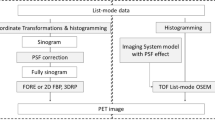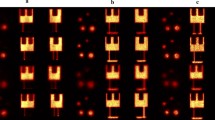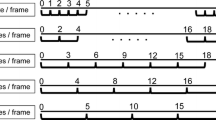Abstract
Image quality in positron emission tomography (PET) is affected by random and scattered coincidences and reconstruction protocols. In this study, we investigated the effects of scattered and random coincidences from outside the field of view (FOV) on PET image quality for different reconstruction protocols. Imaging was performed on the Discovery 690 PET/CT scanner, using experimental configurations including the NEMA phantom (a body phantom, with six spheres of different sizes) with a signal background ratio of 4:1. The NEMA phantom (phantom I) was scanned separately in a one-bed position. To simulate the effect of random and scatter coincidences from outside the FOV, six cylindrical phantoms with various diameters were added to the NEMA phantom (phantom II). The 18 emission datasets with mean intervals of 15 min were acquired (3 min/scan). The emission data were reconstructed using different techniques. The image quality parameters were evaluated by both phantoms. Variations in the signal-to-noise ratio (SNR) in a 28-mm (10-mm) sphere of phantom II were 37.9% (86.5%) for ordered-subset expectation maximization (OSEM-only), 36.8% (81.5%) for point spread function (PSF), 32.7% (80.7%) for time of flight (TOF), and 31.5% (77.8%) for OSEM + PSF + TOF, respectively, indicating that OSEM + PSF + TOF reconstruction had the lowest noise levels and lowest coefficient of variation (COV) values. Random and scatter coincidences from outside the FOV induced lower SNR, lower contrast, and higher COV values, indicating image deterioration and significantly impacting smaller sphere sizes. Amongst reconstruction protocols, OSEM + PSF + TOF and OSEM + PSF showed higher contrast values for sphere sizes of 22, 28, and 37 mm and higher contrast recovery coefficient values for smaller sphere sizes of 10 and 13 mm.








Similar content being viewed by others
References
X. Yang, H. Peng, The use of noise equivalent count rate and the NEMA phantom for PET image quality evaluation. Phys. Med. 31, 179–184 (2015). https://doi.org/10.1016/j.ejmp.2015.01.003
A. Ketabi, P. Ghafarian, M.A. Mosleh-Shirazi et al., The influence of using different reconstruction algorithms on sensitivity of quantitative 18F-FDG-PET volumetric measures to background activity variation. Iran. J. Nucl. Med. 26, 87–97 (2018)
A. Mehranian, M.R. Ay, A. Rahmim et al., 3D prior image constrained projection completion for X-ray CT metal artifact reduction. IEEE Trans. Nucl. Sci. 60, 3318–3332 (2013). https://doi.org/10.1109/TNS.2013.2275919
G. Reynés-Llompart, A. Sabaté-Llobera, E. Llinares-Tello et al., Image quality evaluation in a modern PET system: impact of new reconstructions methods and a radiomics approach. Sci. Rep. 9, 10640 (2019). https://doi.org/10.1038/s41598-019-46937-8
J. Yan, J. Schaefferkoette, M. Conti et al., A method to assess image quality for low-dose PET: analysis of SNR, CNR, bias and image noise. Cancer Imaging 16, 26 (2016). https://doi.org/10.1186/s40644-016-0086-0
G. Akamatsu, K. Ishikawa, K. Mitsumoto et al., Improvement in PET/CT image quality with a combination of point-spread function and time-of-flight in relation to reconstruction parameters. J. Nucl. Med. 53, 1716–1722 (2012). https://doi.org/10.2967/jnumed.112.103861
B.S. Halpern, M. Dahlbom, A. Quon et al., Impact of patient weight and emission scan duration on PET/CT image quality and lesion detectability. J. Nucl. Med. 45, 797–801 (2004)
R. Minamimoto, C. Levin, M. Jamali et al., Improvements in PET image quality in time of flight (TOF) simultaneous PET/MRI. Mol. Imaging Biol. 18, 776–781 (2016). https://doi.org/10.1007/s11307-016-0939-8
J.-Y. Chen, J.F. Tong, Z.L. Hu et al., Evaluation of neutron beam characteristics for D-BNCT01 facility. Nucl. Sci. Tech. 33, 12 (2022). https://doi.org/10.1007/s41365-022-00996-1
J.S. Karp, S. Surti, M.E. Daube-Witherspoon et al., Benefit of time-of-flight in PET: experimental and clinical results. J. Nucl. Med. 49, 462–470 (2008). https://doi.org/10.2967/jnumed.107.044834
D.J. Kadrmas, M.E. Casey, M. Conti et al., Impact of time-of-flight on PET tumor detection. J. Nucl. Med. 50, 1315–1323 (2009). https://doi.org/10.2967/jnumed.109.063016
N. Belcari, F. Attanasi, S. Moehrs et al., A novel random counts estimation method for PET using a symmetrical delayed window technique and random single event acquisition, in 2009 IEEE Nuclear Science Symposium Conference Record (NSS/MIC), Orlando, FL, USA (2009), pp. 3611–3614. https://doi.org/10.1109/NSSMIC.2009.5401833
J.F. Oliver, M. Rafecas, Improving the singles rate method for modeling accidental coincidences in high-resolution PET. Phys. Med. Biol. 55, 6951–6971 (2010). https://doi.org/10.1088/0031-9155/55/22/022
C.W. Stearns, D.L. McDaniel, S.G. Kohlmyer et al., Random coincidence estimation from single event rates on the Discovery ST PET/CT scanner, in 2003 IEEE Nuclear Science Symposium, Conference Record (IEEE Cat. No. 03CH37515), Portland, OR, USA, Vol. 5 (2003), pp. 3067–3069. https://doi.org/10.1109/NSSMIC.2003.1352545
J.F. Oliver, M. Rafecas, Modelling random coincidences in positron emission tomography by using singles and prompts: a comparison study. PLoS One 11, 1–22 (2016). https://doi.org/10.1371/journal.pone.0162096
L. Presotto, L. Gianolli, M.C. Gilardi et al., Evaluation of image reconstruction algorithms encompassing time-of-flight and point spread function modelling for quantitative cardiac PET: phantom studies. J. Nucl. Cardiol. 22, 351–363 (2015). https://doi.org/10.1007/s12350-014-0023-1
D.G. Politte, D.L. Snyder, Corrections for accidental coincidences and attenuation in maximum-likelihood image reconstruction for positron-emission tomography. IEEE Trans. Med. Imag. 10, 82–89 (1991). https://doi.org/10.1109/42.75614
C.C. Watson, Count rate dependence of local signal-to-noise ratio in positron emission tomography. IEEE Trans. Nucl. Sci. 51, 2670–2680 (2004). https://doi.org/10.1109/TNS.2004.835743
S.C. Strother, M.E. Casey, E.J. Hoffman, Measuring PET scanner sensitivity: relating countrates to image signal-to-noise ratios using noise equivalent counts. IEEE Trans. Nucl. Sci. 37, 783–788 (1990). https://doi.org/10.1109/23.10671
T. Chang, G. Chang, S. Kohlmyer, Effects of injected dose, BMI and scanner type on NECR and image noise in PET imaging. Phys. Med. Biol. 56, 5275 (2011). https://doi.org/10.1088/0031-9155/56/16/013
M. Dahlbom, C. Schiepers, J. Czernin, Comparison of noise equivalent count rates and image noise. IEEE Trans. Nucl. Sci. 52, 1386–1390 (2005). https://doi.org/10.1109/TNS.2005.858176
T. Chang, G. Chang, J.W. Clark et al., Reliability of predicting image signal-to-noise ratio using noise equivalent count rate in PET imaging. Med. Phys. 39, 5891–5900 (2012). https://doi.org/10.1118/1.4750053
R. Matheoud, C. Secco, P. Della Monica et al., The effect of activity outside the field of view on image quality for a 3D LSO-based whole body PET/CT scanner. Phys. Med. Biol. 54, 5861–5872 (2009). https://doi.org/10.1088/0031-9155/54/19/013
D.F.C. Hsu, A. Vandenbroucke, D.R. Innes et al., Effects of out of field-of-view activity on imaging performance in a 1mm3 resolution clinical PET system, in 2014 IEEE Nuclear Science Symposium and Medical Imaging Conference (NSS/MIC), Seattle, WA, USA (2014), pp. 1–3. https://doi.org/10.1109/NSSMIC.2014.7430988
Y. Berker, A. Salomon, F. Kiessling et al., Out-of-field activity in the estimation of mean lung attenuation coefficient in PET/MR. Nucl. Instrum. Methods Phys. Res. A 734, 206–209 (2014). https://doi.org/10.1016/j.nima.2013.08.060
K.A. Wangerin, S. Ahn, S. Wollenweber et al., Evaluation of lesion detectability in positron emission tomography when using a convergent penalized likelihood image reconstruction method. J. Med. Imag. 4, 011002 (2016). https://doi.org/10.1117/1.jmi.4.1.011002
K. Miwa, K. Wagatsuma, R. Nemoto et al., Detection of sub-centimeter lesions using digital TOF-PET/CT system combined with Bayesian penalized likelihood reconstruction algorithm. Ann. Nucl. Med. 34, 762–771 (2020). https://doi.org/10.1007/s12149-020-01500-8
N. Hashimoto, K. Morita, Y. Tsutsui et al., Time-of-flight information improved the detectability of subcentimeter spheres using a clinical PET/CT scanner. J. Nucl. Med. Technol. 46, 268–273 (2018). https://doi.org/10.2967/jnmt.117.204735
N.J. Vennart, N. Bird, J. Buscombe et al., Optimization of PET/CT image quality using the GE ‘Sharp IR’ point-spread function reconstruction algorithm. Nucl. Med. Commun. 38, 471–479 (2017). https://doi.org/10.1097/MNM.0000000000000669
S.K. Øen, L.B. Aasheim, L. Eikenes et al., Image quality and detectability in Siemens Biograph PET/MRI and PET/CT systems—a phantom study. EJNMMI Phys. 6, 16 (2019). https://doi.org/10.1186/s40658-019-0251-1
H. Hemmati, A. Kamali-Asl, M. Ay et al., Compton scatter tomography in TOF-PET. Phys. Med. Biol. 62, 7641 (2017). https://doi.org/10.1088/1361-6560/aa82ab
G. E. Healthcare (Discovery PET/CT 690 VCT edition that includes ASiR and SnapShot Pulse options, in GE Healthcare, a division of General Electric Company 2010). www.gehealthcare.com. Accessed 18 June 2023
G. E. Healthcare (Discovery PET/CT 690, GE Healthcare, a division of General Electric Company, 2010). www.gehealthcare.com. Accessed 18 June 2023
R. Matheoud, M. Lecchi, D. Lizio et al., Erratum to: comparative analysis of iterative reconstruction algorithms with resolution recovery and time of flight modeling for 18 F-FDG cardiac PET: a multicenter phantom study. J. Nucl. Cardiol. 24, 1101 (2017). https://doi.org/10.1007/s12350-016-0415-5
J.M. Rogasch, S. Suleiman, F. Hofheinz et al., Reconstructed spatial resolution and contrast recovery with Bayesian penalized likelihood reconstruction (Q.Clear) for FDG-PET compared to time-of-flight (TOF) with point spread function (PSF). EJNMMI Phys. 7, 2 (2020). https://doi.org/10.1186/s40658-020-0270-y
S. Surti, J.S. Karp, Impact of detector design on imaging performance of a long axial field-of-view, whole-body PET scanner. Phys. Med. Biol. 60, 5343 (2015). https://doi.org/10.1088/0031-9155/60/13/5343
M.O. Alamdari, P. Ghafarian, P. Geramifar et al., Evaluation of the impact of out-of-axial FOV scattering medium on random coincidence rates on discovery 690 PET/CT scanner: a simulation study. Front. Biomed. Technol. 181–189 (2019). https://doi.org/10.18502/FBT.V6I4.2211
T. Carlier, L. Ferrer, H. Necib et al., Clinical NECR in 18F-FDG PET scans: optimization of injected activity and variable acquisition time. Relationship with SNR. Phys. Med. Biol. 59, 6417–6430 (2014). https://doi.org/10.1088/0031-9155/59/21/6417
S. Surti, Update in time-of-flight PET imaging. J. Nucl. Med. 56, 98–105 (2014). https://doi.org/10.2967/jnumed.114.145029
M. Shekari, P. Ghafarian, S. Ahangari et al., Quantification of the impact of TOF and PSF on PET images using the noise-matching concept: clinical and phantom study. Nucl. Sci. Tech. 28, 167 (2017). https://doi.org/10.1007/s41365-017-0308-6
R. Sharifpour, P. Ghafarian, A. Rahmim et al., Quantification and reduction of respiratory induced artifacts in positron emission tomography/computed tomography using the time-of-flight technique. Nucl. Med. Commun. 38, 948–955 (2017). https://doi.org/10.1097/MNM.0000000000000732
J. Schaefferkoetter, M. Casey, D. Townsend et al., Clinical impact of time-of-flight and point response modeling in PET reconstructions: a lesion detection study. Phys. Med. Biol. 58, 1465–1478 (2013). https://doi.org/10.1088/0031-9155/58/5/1465
R. Sharifpour, P. Ghafarian, M. Bakhshayesh-Karam et al., Impact of time-of-flight and point-spread-function for respiratory artifact reduction in PET/CT imaging: focus on standardized uptake value. Tanaffos 16, 127–135 (2017)
G. Akamatsu, K. Mitsumoto, K. Ishikawa et al., Benefits of point-spread function and time of flight for PET/CT image quality in relation to the body mass index and injected dose. Clin. Nucl. Med. 38, 407–412 (2013). https://doi.org/10.1097/RLU.0b013e31828da3bd
S. Rezaei, P. Ghafarian, A.K. Jha et al., Joint compensation of motion and partial volume effects by iterative deconvolution incorporating wavelet-based denoising in oncologic PET/CT imaging. Phys. Med. 68, 52–60 (2019). https://doi.org/10.1016/j.ejmp.2019.10.031
A. Suljic, P. Tomse, L. Jensterle et al., The impact of reconstruction algorithms and time of flight information on PET/CT image quality. Radiol. Oncol. 49, 227–233 (2015). https://doi.org/10.1515/raon-2015-0014
D. Brasse, P.E. Kinahan, C. Lartizien et al., Correction methods for random coincidences in fully 3D whole-body PET: impact on data and image quality. J. Nucl. Med. 46, 859–867 (2005)
I. Lajtos, J. Czernin, M. Dahlbom et al., Cold wall effect eliminating method to determine the contrast recovery coefficient for small animal PET scanners using the NEMA NU-4 image quality phantom. Phys. Med. Biol. 59, 2727–2746 (2014). https://doi.org/10.1088/0031-9155/59/11/2727
Author information
Authors and Affiliations
Contributions
All authors contributed to the study conception and design. PG, MRA, and AR were involved in technical contribution of the study. Clinical contribution was performed by MBK. Material preparation, data collection and analysis were performed by MOA. The first draft of the manuscript was written by MOA and all authors commented on previous versions of the manuscript. All authors read and approved the final manuscript.
Corresponding author
Ethics declarations
Conflict of interest
The authors declare that they have no competing interests.
Additional information
This work was supported by the Tehran University of Medical Sciences under Grant No. 36291 and PET/CT and Cyclotron Center of Masih Daneshvari Hospital at Shahid Beheshti University of Medical Sciences.
Rights and permissions
Springer Nature or its licensor (e.g. a society or other partner) holds exclusive rights to this article under a publishing agreement with the author(s) or other rightsholder(s); author self-archiving of the accepted manuscript version of this article is solely governed by the terms of such publishing agreement and applicable law.
About this article
Cite this article
Alamdari, M.O., Ghafarian, P., Rahmim, A. et al. Impact of random and scattered coincidences from outside of field of view on positron emission tomography/computed tomography imaging with different reconstruction protocols. NUCL SCI TECH 34, 184 (2023). https://doi.org/10.1007/s41365-023-01321-0
Received:
Revised:
Accepted:
Published:
DOI: https://doi.org/10.1007/s41365-023-01321-0




